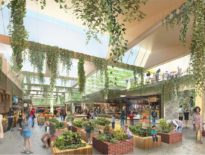Why Equity Matters for Everyone: A New Value Proposition for Design
“Equity” and “equality” have long been used interchangeably, but the terms are often confused with each other. While the focus of equality is framed with sameness being the end goal, equity may be defined as a state in which all people, regardless of their socioeconomic, racial, or ethnic grouping, have fair and just access to the resources and opportunities necessary to thrive. Beyond equity’s newer association with pluralism, it has long been connected to financial capital, as well as to collective ownership, vested interest, and a sense of value or self-worth.
Equity has a strong potential as a new paradigm and social construct to succeed on multiple levels—equity in education, equitable practice in the workplace, and social equity in access to basic life resources, healthy and safe communities, and public space in our urban centers. The equity-focused value proposition at all these levels is rooted in transparency, education, collaboration, and trust.
The lack of equity in architectural practice and allied professions has made them prone to lose talent to other seemingly more lucrative career paths due to multiple factors that challenge retention: long hours, low pay, lack of transparency for promotion, and work that is misaligned with professional goals. In order to have justice and equity in the built environment, the AEC design workforce needs a more diverse representation that reflects the rapidly changing demographics that we serve. We are also prone to the public not fully understanding the value of what architects and allied professionals bring to the table in terms of the social impact of design that can inform equitable, just, and sustainable public and private spaces.
There are several areas where the lack of equity and diversity in design participation and consideration results in deficiencies in public space. For example, the design and planning of public restrooms may not seem obvious to all, but those who must endure the challenges of their shortcomings can inform design professionals. The design of public restrooms typically segregates into binary gender designations, and the traditional design of semi-private stalls in similar ratios between males and females often results in longer wait times for females, particularly at large assembly or transit spaces such as airports, train stations, etc. The design of public restrooms based on binary gender also prevents parents of opposite genders from assisting their young children and possibly risks health and safety for kids going in by themselves. And more recently, there has been great public debate about the laws passed in North Carolina that prevent the transgender community from access to binary gender public restrooms.

Within these challenges, there is a great design opportunity to address equitable access to restrooms as well as to propose reformed public policy that recognizes the basic human right to have adequate access to public restrooms. Several cities (including San Francisco, Philadelphia, Seattle, and West Hollywood) and public institutions have adopted gender-neutral restroom policies and designs that accommodate fair access to these public facilities. Designers are part of the solution as well, proposing private, gender-neutral restrooms that are essentially a row of individual toilet stall “rooms” with full doors that open onto a common area where everyone can wash their hands at a row of sinks and check the mirror. Another design solution is designated, family-friendly restrooms that recognize a single parent managing the needs of multiple children in a public setting.
Another aspect for design consideration is the equitable access to public space that accommodates actions often viewed as “private space” activities. Nursing mothers have historically been marginalized when trying to find public space with privacy for breastfeeding or designated clean space for pumping in the workplace. While providing such spaces may be viewed as special treatment for a particular group and not “equal” or fair, the spaces are equitable in allowing mothers who are returning to workforce to have supporting resources.
Additionally, there is a significant lack of access to safe public space for school-aged children between the time that school ends and when their parents return from work. In particular, these types of spaces are needed most by single parents who don’t have access to childcare resources.
Finally, the most troubling aspect of equitable access to the safe, healthy, affordable communities is heavily influenced by structural bias based on race, ethnicity and immigration status. In April of 2016, the Wall Street Journal reported that “Where you live could determine how long you live.”[1] Important indicators like education levels, poverty, commute times, quality of housing, access to fresh food, and clear air and water correlate with location to greatly influence life expectancy. One of the stark examples in the study: the difference in life expectancies between New Orleans’ French Quarter and Lower Garden District, only a few miles apart, can be as high as 25 years.
The 2016 Equity in Architecture Survey conducted by AIA SF Equity by Design earlier this year, coupled with an interactive discussion, will encourage the development of equitable practices for increasing diversity, expanding career opportunities to retain practitioners. By better representing the populations we are meant to serve and developing empathy in design professionals who are more socially and environmentally conscious of design’s influence to create equitable space for all, we can have greater impact for retaining talent with meaningful work, gaining commissions on projects focused on social justice and access, and producing design outcomes that are valued by the client and community. The results of the survey will be launched on October 29th at the fourth symposium hosted by AIA San Francisco, Equity by Design: Metrics, Meaning & Matrices.

Social and environmental equity have a direct impact on improving opportunities for not only the historically disadvantaged populations, but also has the potential for economic prosperity for all. In terms of physical space, fair access to environmentally safe places for residency, education, employment and full participation in the political and cultural life of the community is one of the greatest challenges that we as a society face today.
Equitable Design has the power to problem solve on multiple levels including social situations. A recent example was featured in Huffington Post, with a clever video Op-Ed by Esther Sperber, owner of Studio ST Architecture.[2] The New York architect offers an “out-of-the-box” solution to the ongoing “gender-charged restroom” debate in an animated video in the post.
“It became clear to me that the typical gender divided public bathroom creates inconvenient situations which affect a wide range of the population,” Sperber said. “Innovative solutions, both in architectural design and in other fields, often emerge when the problem itself is redefined.” By designing bathrooms by size—small, medium, large, extra-large, etc.—Sperber provides special efficiency, sustainability, safety, and equitable access.
Equitable Design in the workplace and in our interactions in practice with clients and communities has the ability to bring about unique problem-solving skills to highly political issues related to access of essential services, public space, affordable real estate, and urban resources.
[1] http://blogs.wsj.com/economics/2016/04/11/where-you-live-could-determine-how-long-you-live/
[2] http://www.huffingtonpost.com/entry/transgender-bathroom-esther-sperber_us_5783e590e4b01edea78ef6da?


